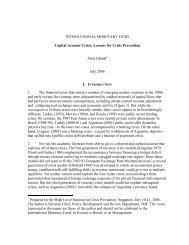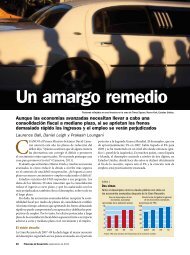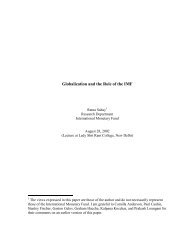Chapter 20: Taxation of Corporate Reorganizations - IMF
Chapter 20: Taxation of Corporate Reorganizations - IMF
Chapter 20: Taxation of Corporate Reorganizations - IMF
Create successful ePaper yourself
Turn your PDF publications into a flip-book with our unique Google optimized e-Paper software.
Tax Law Design and Drafting (volume 2; International Monetary Fund: 1998; Victor Thuronyi, ed.)<br />
<strong>Chapter</strong> <strong>20</strong>, <strong>Taxation</strong> <strong>of</strong> <strong>Corporate</strong> <strong>Reorganizations</strong><br />
holders, shares only in company B. As long as all or the largest part <strong>of</strong> the shareholders continue<br />
their equity interest in one <strong>of</strong> the transferee companies, the reorganization should maintain its<br />
tax-exempt character.<br />
7. Elective Taxable Treatment<br />
Treatment <strong>of</strong> a proposed transaction as taxable or tax free is <strong>of</strong>ten elective in that the<br />
taxpayer can change the form <strong>of</strong> the transaction slightly to make it qualify as tax free or, if the<br />
taxpayer considers it more advantageous, to make it fail to qualify. Some countries go beyond<br />
this degree <strong>of</strong> electivity in some cases by allowing the taxpayer to elect for particular<br />
transactions whether it will be treated as taxable or as a tax-free reorganization. 66 The theory<br />
behind this approach is that it is inefficient to require the taxpayer to manipulate the corporate<br />
form <strong>of</strong> the reorganization to accomplish the particular tax result desired.<br />
8. Requiring Approval<br />
Although there are disadvantages in requiring approval from the tax authorities before a<br />
transaction can be engaged in (delays may impede transactions and approval requirements may<br />
be invitations for corruption), the technique <strong>of</strong> requiring a ruling from the tax authority before a<br />
reorganization can be carried out on a tax-free basis 67 does have the advantage <strong>of</strong> simplifying the<br />
drafting requirements and alleviating the concern that statutory rules allowing such transactions<br />
might be used for tax avoidance. Approval requirements might be impractical in countries<br />
experiencing a large volume <strong>of</strong> reorganizations, but might be manageable in countries where this<br />
is not the case.<br />
C. Tax Consequences <strong>of</strong> Tax-Free <strong>Reorganizations</strong><br />
1. Tax Position <strong>of</strong> the Transferor Company<br />
The tax exemption <strong>of</strong> a reorganization in itself is very simple: no tax is levied on the gain<br />
that is realized in exchange for shares. 68 When the reorganization rules allow compensation<br />
partly in shares and partly in cash and other property, the most common approach is to provide a<br />
partial exemption. This means that the gains realized in a reorganization will be tax exempt to<br />
the extent that the transfer <strong>of</strong> assets by the transferor is compensated by voting shares <strong>of</strong> the<br />
66 Germany allows the transferor company an option to choose between a tax exempt and a taxable transfer; see<br />
UmwStG §11. This choice will <strong>of</strong> course be agreed upon between the parties to a reorganization. When the<br />
transferor company elects a tax-free reorganization, the conditions are such that the continuity <strong>of</strong> shareholders and<br />
business activity is guaranteed so that the tax liability is only deferred. In the United States, a corporation that<br />
purchases the stock <strong>of</strong> a target company may elect to treat the transaction as a taxable purchase <strong>of</strong> the assets <strong>of</strong> the<br />
target, followed by the contribution <strong>of</strong> the assets to a new corporation. See IRC § 338.<br />
67 E.g., FRA CGI § 210B (requiring approval for divisions and contributions <strong>of</strong> part <strong>of</strong> a corporation’s assets). See<br />
Bernard Chesnais and Yann de Givré, France, in 79b Cahiers de droit fiscal international 139, 142–43 (1994).<br />
68 See BEL CIR § 45; FRA CGI § 210 A. However the transferor company can elect taxable treatment for the<br />
transaction, in which case a concessional rate <strong>of</strong> 18 percent applies, see FRA CGI § 210 A - 4; USA IRC § 354 (a).<br />
- <strong>20</strong> -
















